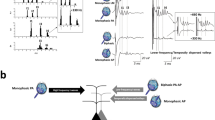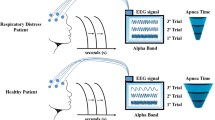Abstract
This study was designed to determine whether a silent period could be elicited in the diaphragm electromyographic (EMG) activity by transcranial magnetic stimulation (TMS) of the motor cortex and, if so, to assess the influence of reflex or voluntary control of breathing on diaphragmatic cortical silent period (cSP). Diaphragmatic EMG activity was recorded in six healthy volunteers after motor cortex TMS triggered by the inspiratory flow peak and applied during forced inspiration (FI), voluntary hyperventilation (vHV) and reflex hyperventilation (rHV) to a CO2 stimulus. Electrophysiological and respiratory parameters were studied, including diaphragmatic cSP duration and transdiaphragmatic pressure swing (ΔPdi). A diaphragmatic cSP was found and correlated with ΔPdi values. ΔPdi and cSP duration were similar in the vHV and rHV conditions but were significantly increased during FI. This study established for the first time the existence of a diaphragmatic cSP to motor cortex TMS. The diaphragmatic cSP duration depended on the magnitude of the respiratory effort, as assessed by ΔPdi, but not on the mechanism (volitional or reflex) of diaphragm activation.
Similar content being viewed by others
Author information
Authors and Affiliations
Corresponding author
Rights and permissions
About this article
Cite this article
Lefaucheur, JP., Lofaso, F. Diaphragmatic silent period to transcranial magnetic cortical stimulation for assessing cortical motor control of the diaphragm. Exp Brain Res 146, 404–409 (2002). https://doi.org/10.1007/s00221-002-1197-3
Received:
Accepted:
Published:
Issue Date:
DOI: https://doi.org/10.1007/s00221-002-1197-3




